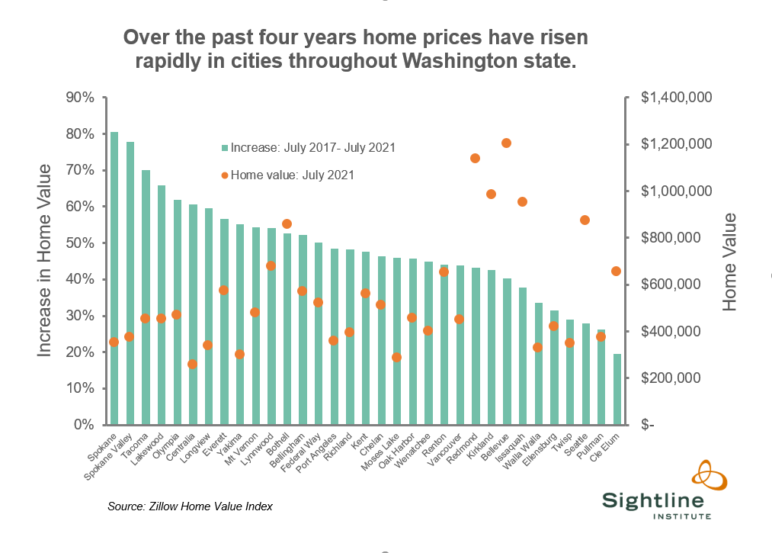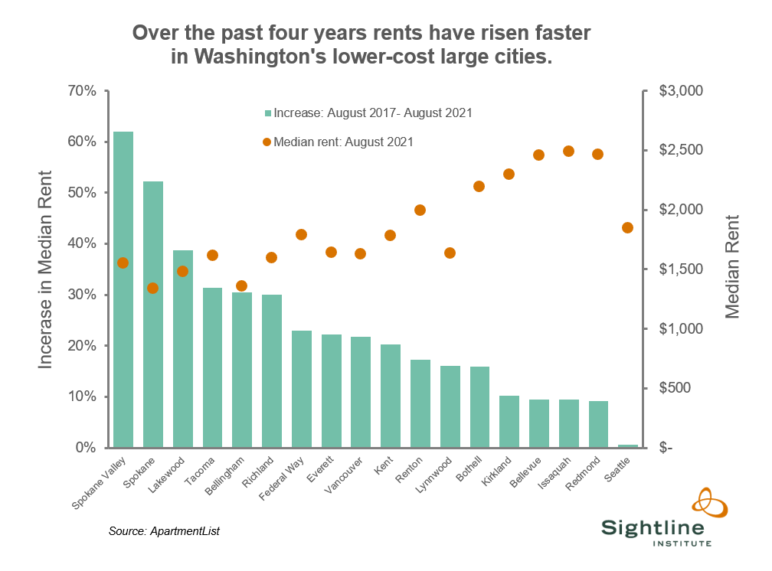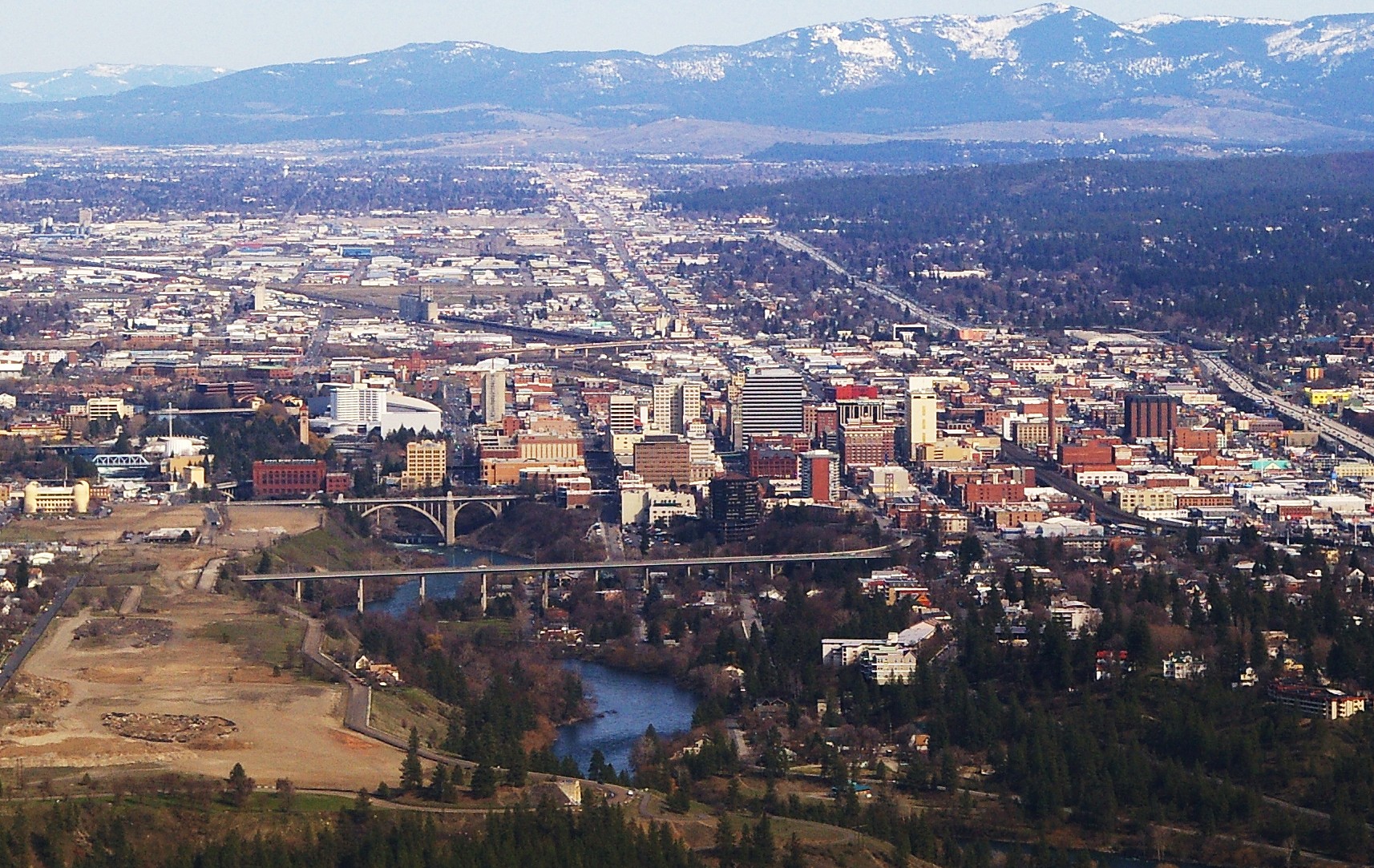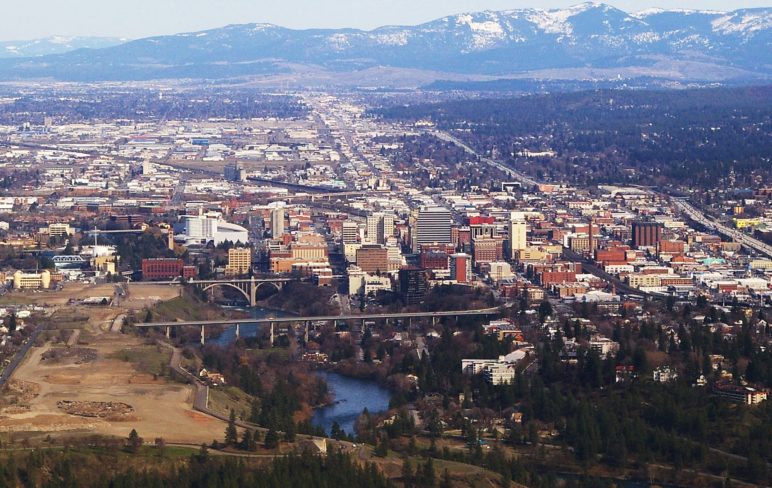Soaring home prices in the tech-booming Seattle metro have been the stuff of headlines for decades. But recently, cities of all sizes throughout Washington state are feeling the pain of a statewide shortage of homes. Over the past few years, price increases in Seattle have been dwarfed by those in smaller cities near and far.
The state’s current runaway price champ? Spokane, where from 2017 to 2021, home values rose by 81 percent, and rents by 52 percent (scroll to the charts below to see the rundown).
In absolute terms, Seattle metro’s housing costs are still the most exorbitant in the state. What hurts residents most, though, is when housing takes a bigger and bigger bite out of their paychecks. Usually, home prices more or less track with local incomes. But in most Washington cities, surging home prices and rents are leaving incomes in the dust.
Washington’s statewide tsunami of home price escalation demonstrates how housing shortages spill across city boundaries. And it follows that the solution hinges on enacting statewide standards to boost the production of homes.
The critical target for state-level action is to loosen the stranglehold of local zoning laws that ban anything but detached houses with big yards and driveways on roughly three quarters of the state’s residential land. These exclusionary rules kill affordability in two ways: they mandate the most expensive kind of home, and they severely constrict the number of homes in places where people want to live. And as called out by the Biden White House, they’ve also “systemically discriminated against Black families” and “played a role in causing racial disparities in the housing market.”
In 2019, Oregon took the groundbreaking step of legalizing duplexes and fourplexes statewide. Last month, California passed a statewide bill allowing duplexes and lot splits. Washington state’s staggering rent and price trends are practically screaming at Washington lawmakers to do the same.
When there aren’t enough homes, people always get priced out of somewhere
Out-of-reach prices caused by a shortage of homes is a widely discussed national problem, and Washington state is no exception. Pro-housing non-profit Up for Growth estimates that from 2010 to 2015, Washington fell behind on housing production by a whopping 225,600 units.
Recent months have brought stories of prices and rents spiraling out of control throughout the state—in the Wenatchee Valley, Cowlitz County, Spokane, and all over the Puget Sound region. Over the past year alone, Zillow’s typical home price estimate for Washington rose from $434,000 to $530,000, an increase of 22 percent.
Meanwhile, the Building Industry Association of Washington estimates that “every $1,000 increase in the cost of building a new home prices more than 2,500 people out of the market in Washington.”
Washington’s housing crisis has outgrown the Seattle metro
In the first chart below, the green bars show the growth in Zillow’s Home Value Index (more or less equivalent to median home price), and the orange dots show the value as of July 2021. Likewise, the second chart shows the growth in average rent over those same four years along with rents as of July 2021, using estimates derived by ApartmentList. (For the price chart, I selected the 33 cities to give a good cross section of the state, while the cities in the rent chart are all those for which ApartmentList has data).

 The prices and rents tell pretty much the same story. During the past decade, Seattle has frequently landed near or at the top of the list of major US cities for rising housing costs. Over the past four years, however, smaller cities all across the state have seen prices and rents rise far faster than Seattle’s.
The prices and rents tell pretty much the same story. During the past decade, Seattle has frequently landed near or at the top of the list of major US cities for rising housing costs. Over the past four years, however, smaller cities all across the state have seen prices and rents rise far faster than Seattle’s.
This geographic trends are mirrored in historically low apartment vacancy rates in almost all Washington counties excepting the four in the Puget Sound region centered around the Seattle metro. Vacancy rates of one percent or less have become common all over the state.
Topping both the price and rent increase lists are Spokane (pop. 222,000) and adjacent Spokane Valley (pop. 101,000), located about as far away from Seattle as you can get in the state. But big increases also happened all over: prices in 25 of the 33 cities I tracked rose by 40 percent or more.
The state’s most expensive cities—Bellevue, Kirkland, Redmond, and Issaquah—conversely lie near the low end in terms of both price and rent growth. Seattle ranked near the bottom for price growth, and at the very bottom for rent growth. The pandemic had an outsized negative impact on Seattle rents but they’re now roaring back, currently up 5 percent from a year ago.
Exclusionary zoning isn’t the only cause of high prices, but it’s one that the state can fix
Multiple factors are contributing to runaway prices and rents in Washington:
- Production of new homes not keeping up with demand
- Low mortgage interest rates
- 2017 tax reforms that reduced the value of homes in expensive markets
- Millennials entering their prime home buying years
- High-income remote workers moving to lower cost areas
- Outbid buyers forced to rent
- A surge of renters leaving combined households that formed during the pandemic
- Cratering rental vacancy rates (Kitsap County, for example, is at a historically low 3.3 percent)
The pattern is clear in the chart above: rent increased more slowly in expensive cities as demand shifted to lower-cost cities and sent their rents skyward. The squeeze caused by local restrictions on homebuilding in places like Bellevue and Issaquah is spilling over to put the squeeze on places like Tacoma and Richland.
The common denominator: cities throughout Washington haven’t been adding enough homes to keep up with all the people who want to build their lives in the state. The legislature has little control over the above-noted demographic and macroeconomic trends that are pushing up prices. But it does have authority to reform local restrictions that crush the supply of homes—that is, the authority to fix the root problem.
The best time to pass bold, statewide zoning reform was many years ago, but the second-best time is now
Three years ago, a handful of pro-housing Washington lawmakers began introducing statewide zoning reform bills, but so far the legislature has only passed a few incremental ones:
- HB 1923 and HB 2343 offered cities grants to plan zoning reforms and capped certain parking mandates
- SB 6617 lifted parking mandates for accessory dwellings near transit
- SB 5235 ended discriminatory roommate limits
This year, legislators got creative and tried three bills that offered cities a financial incentive if they opted to loosen restrictions on accessory dwellings or legalize small-scale multifamily homes like triplexes. This approach won over the support of cities, but all three bills died nonetheless.
Unfortunately, during those three lost years, Washington’s smoldering housing shortage exploded into a statewide four-alarm blaze. Reversing the grim housing cost trends spotlighted in the price and rent bar charts above calls for multiple fixes in parallel, as soon as possible. Lawmakers can focus on four top priority reforms along these lines:
- Make it easier to add accessory dwellings: reform rules comprehensively (as proposed in HB 2570, for example);
- Allow more homes in residential neighborhoods: legalize up to fourplexes on all residential lots and permit lot splitting;
- Allow more homes near transit: legalize four- to six- story apartment buildings on all residential lots located within a half-mile of transit; and
- Lift off-street parking mandates: eliminate minimums for all lots within a half-mile of transit and for all developments with regulated affordable homes.
To address potential displacement that zoning reforms may cause in low-income or BIPOC communities, zoning reform bills can require cities to identify neighborhoods at risk and to enact mitigations (see HB 1157, for example). To go a step further, the state can establish a dedicated fund to target investments in historically marginalized communities and create “anchors against displacement.”
Local control gave us exclusionary zoning; it will take statewide action to purge it
Throughout Washington, local control of zoning has inflicted statewide residential lockdown, creating a shortage of homes that is sending prices and rents off the charts in cities large and small. As I wrote previously, it’s a tragedy of the commons, because individual cities have little to gain by acting alone on zoning reform. Washington’s statewide housing crisis will only get worse until state lawmakers expunge exclusionary zoning laws from cities once and for all.










Kathy Johnson
I have to disagree that zoning is the answer. The issue is affordability to actually build the ADA and DADU. Banks will not finance the construction of these units to homeowners – the homeowner has to take out a high interest construction or personal loan to do it. The developers can get these loans but ordinary folks cannot. I went through the entire permit process in Seattle, cost $65K for the plans and permits for both an ADU and a DADU. Then when the construction cost estimate came it, it was $1.2 million. The banks basically laughed at the idea of spending that amount of money in the Northgate area, across from NSC, the light rail and pedestrian bridge. If the state / city is serious for individuals to build in-fill housing, the financing issue has to be addressed. Agencies should provide no – cost loans for the construction of the units and assist the homeowner in getting a conventional loan once the units are rented. I ended up selling the place to a developer who has the deep pockets. They let the permit expire so I do not know what the idea now is but I am leaving the city and its the new owner’s opportunity.
Steve
Kathy,
Too many people here now in Seattle. Everything is being taxed to extreme levels. Water, sewer, gas, garbage, electricity, food, property taxes, cell phone & internet, insurance ( Health, Home, Transportation ). The idea of high density housing to accommodate the masses and bring down cost, I don’t think so. There’s no quality of life here in Seattle for me and I’ve lived here most of my life. The time for planning, controlled growth with responsible revenue intake to support it was years ago. There are a lot of people leaving Seattle and Washington now cuz they just can’t afford to live here. We are being priced out, pay up or move on?
BH
a half mile from transit in-city is almost every lot. Maybe that’s the idea.
I support allowing 2-4 unit structures on what are now “single family” lots provided some effort is made to blend with the rest of the neighborhood and not overwhelm the parking situation – sorry but most people outside dense city cores are going to have a car. A two story 4-plex with 1000sf 2 or 3br units and below grade parking could blend in fine on a street of mostly midcentury split level homes for example.
Allowing 4 or 6 story complexes to pop up almost anywhere though would add a lot of risk to ownership of a smaller property or a single family home if such a project were built right next door – may sound good to urbanists but will start to drive out of the city many people who can and want to own their own four walls and roof. These people pay a lot of the taxes and do a lot of the skilled work and have options.
Incremental, gradual changes in zoning are the right way forward,.
Julie Alexandra Mounts
Great article!
Alec
Well, there’s car use and car ownership and parking. Denser zoning naturally creates the market for more frequent transportation options. Car, van, or truck sharing more like Holland than the stuff around the airport, and more rideshare drivers and delivery services would be around those areas. Plus many commercial areas could be a part if the same residential building. If a playground with screaming kids can be next to single family zones, I see no reason why many other operations serving basic needs can’t. Local gov can target what service those around the block need to travel the longest distance for. Then over a longer timeframe, transit authorities like Metro and Sound Transit would have the ability, fiscally and politically, to increase the frequency of service. Not only because ridership would increase but the taxable revenue per block of an area transit serves would increase with more dwellings on it. There would also be a political pressure to finally make street facilities ADA compliant and walkable, or to at least connect non-arterial, low speed cul-de-sac roads so the majority of trips could be done on foot or with a shared ebike. They wouldn’t
even need to be paved or over 5′ wide. A more bike and pedestrian populated street would make them safer for more of such traffic, from drivers with the best intentions and crime in general.
Alec Billroth-MacLurg
aaand if they need to use a car for work, I would guess a considerable number would carpool or get support from their employer.
H
The state needs more single family housing. Eventually people have children need private outdoor space and more interior space. The fact that quality family housing that is attainable without a deep six figure salary and $100k+ cash available does not exist within commuting distance to Seattle or Bellevue is outrageous.
You think you did good because you managed to save another $50k last year but home prices went up $90k. Good thing they’re building lots of apartments to house couples in their late 30s who aren’t having kids because they can’t afford housing AND childcare. Wait until businesses start leaving because they can’t retain any of their employees once they get old enough to start a family.